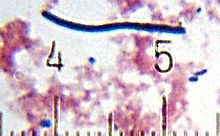There are lots of different "yogurts" but they all have some similar beginnings. The characteristic taste, texture and smell of yogurt comes from two bacteria; Lactobacillus bulgaricus (a rod shaped bacteria)
 and Streptococcus thermophilus
and Streptococcus thermophilus  ( a round shaped bacteria).
( a round shaped bacteria). These guys work well together
- Rod/cocci blends grow together in a relationship referred to as 'mutualism' where the overall growth rate and acid production is faster than either culture on its own. The rods produce amino acids and peptides which stimulate the growth of cocci, and the cocci produce formic acid which is required by rods.
- The balance between the rods and cocci can be controlled by temperature and pH
- The cocci prefer higher temperatures (optimum about 46C) than the rods (optimum about 39C).
- The rods are more acid tolerant than the cocci, so, normally the cocci develop the initial acidity and out grow the rods. But, as the acidity increases the rods begin to grow faster than the cocci.
As an added bonus the L. bulgaricus produces acetaldehyde  this is the chemical that gives yogurt its familiar taste and smell.
this is the chemical that gives yogurt its familiar taste and smell.
 this is the chemical that gives yogurt its familiar taste and smell.
this is the chemical that gives yogurt its familiar taste and smell.
The low pH gives yogurt it's tangy bite and also the low pH starts to denature the Casein proteins and makes the yogurt nice and thick.
A note on ProBiotics" Lactobacillus acidophilus - Acidophilus bacteria are one of the homofermentative species that like the other bacteria in this receipe ferment milk sugar Lactose to lactic acid and grow well at pH <5.0 and temperatures of 37 C. The commercial starter I used contained L. acidophilus. A range of lactic acid bacteria are naturally occuring in human systems and are considered to contribute to a wide range of positive health impacts.
A note on ProBiotics" Lactobacillus acidophilus - Acidophilus bacteria are one of the homofermentative species that like the other bacteria in this receipe ferment milk sugar Lactose to lactic acid and grow well at pH <5.0 and temperatures of 37 C. The commercial starter I used contained L. acidophilus. A range of lactic acid bacteria are naturally occuring in human systems and are considered to contribute to a wide range of positive health impacts.
The Recipe
1./ Heat milk (I used Kroger skimmed milk) to 180 F for a few minutes. The idea here is to kills all the bacteria that might be present in the milk and eliminate unwanted competition.


2./ Cover and let cool to 112F and add the starter. In this case the starter I am using is a freeze dried commercial starter but if you save about a cup your yogurt and use that as the starter. The bacteria will wake up once they hit the hot sugary milk and do their stuff. If you want thicker yogurt add up to 1/2 cup of dry milk powder per quart of milk. What you are doing is increasing the milk solids - so it ends up thicker.
3./ Let stand for 2-4 hours at this temperature. I used a Yogotherm unit. This is just an insulated box. The longer you leave it the thicker it gets because you are making it more acidic - but the tangier it gets - you choose.
 |
| Thick and creamy and tangy after 4 hours |
4./ Refrigerate - this stops the bacteria from being active (it doesn't necessarily mill them, so they are ready to be used as the starter for the next batch).
5./ Eat just as it is or blend in some fruit or honey.
.




No comments:
Post a Comment